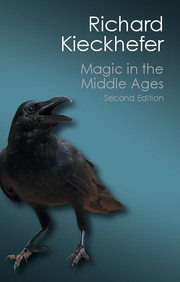Book contents
- Frontmatter
- Contents
- List of illustrations
- Foreword to the Canto edition
- Preface
- 1 INTRODUCTION: MAGIC AS A CROSSROADS
- 2 THE CLASSICAL INHERITANCE
- 3 THE TWILIGHT OF PAGANISM: MAGIC IN NORSE AND IRISH CULTURE
- 4 THE COMMON TRADITION OF MEDIEVAL MAGIC
- 5 THE ROMANCE OF MAGIC IN COURTLY CULTURE
- 6 ARABIC LEARNING AND THE OCCULT SCIENCES
- 7 NECROMANCY IN THE CLERICAL UNDERWORLD
- 8 PROHIBITION, CONDEMNATION, AND PROSECUTION
- Further reading
- Index
Foreword to the Canto edition
Published online by Cambridge University Press: 05 October 2014
- Frontmatter
- Contents
- List of illustrations
- Foreword to the Canto edition
- Preface
- 1 INTRODUCTION: MAGIC AS A CROSSROADS
- 2 THE CLASSICAL INHERITANCE
- 3 THE TWILIGHT OF PAGANISM: MAGIC IN NORSE AND IRISH CULTURE
- 4 THE COMMON TRADITION OF MEDIEVAL MAGIC
- 5 THE ROMANCE OF MAGIC IN COURTLY CULTURE
- 6 ARABIC LEARNING AND THE OCCULT SCIENCES
- 7 NECROMANCY IN THE CLERICAL UNDERWORLD
- 8 PROHIBITION, CONDEMNATION, AND PROSECUTION
- Further reading
- Index
Summary
The history of magic is in some respects closely linked to that of witchcraft, but the issues in the history of magic are not so well established. In historical scholarship over the last three decades, certain problems have emerged as basic to the study of witchcraft: why did the witch trials in Western Europe occur just when they did, from the fifteenth to the seventeenth centuries? Why did many of the religious and intellectual leaders of the age encourage this prosecution? What does it mean that women were disproportionately accused of witchcraft, and that when witch-hunting reached its severest intensity women were overwhelmingly its victims? Why was witch-hunting less virulent in countries with tightly centralized judicial apparatus, such as Spain and Italy? But when we turn to the history of magic we find that the questions and issues are much less sharply defined.
One might even be tempted to ask whether magic in fact has a history, if by history one means the story of distinct beginnings, developments, and endings that can be explained with reference to other factors in the society and culture of an era. Magic, some might argue, is simply a perennial dimension of culture: people were practising forms of magic in earliest recorded times, and well into modern days some people have continued to experiment with these same forms.
- Type
- Chapter
- Information
- Magic in the Middle Ages , pp. ix - xiiiPublisher: Cambridge University PressPrint publication year: 2014



